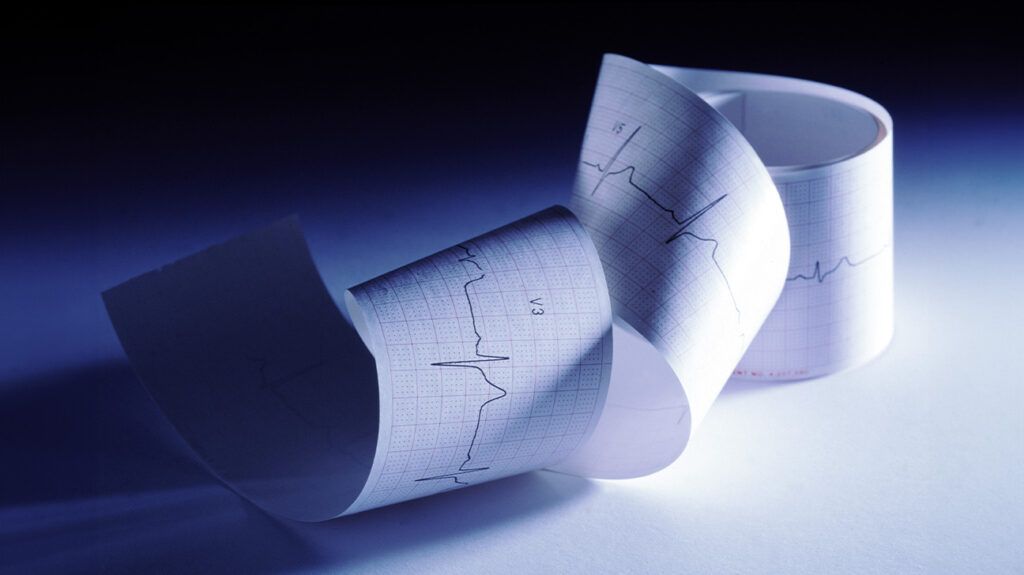Electrocardiograms (EKGs) can help diagnose heart failure by measuring the electrical activity of the heartbeat. Doctors use EKGs alongside other tests to help assess heart failure.
Heart failure occurs when the heart is unable to pump blood around the body efficiently. This can lead to a range of symptoms. Early detection is important for effective management.
This article explains what an EKG is and how they help doctors detect heart failure. It also outlines the potential for EKGs to detect past symptoms of heart failure and predict future risk.

An EKG cannot provide a definitive diagnosis of heart failure on its own. However, it can reveal signs that the heart may be under stress.
EKGs assess the heart’s electrical activity, recording the heart’s rhythm and electrical impulses as waves. There are
For example, a potential cause of heart failure is cardiomyopathy. This is when the walls of the heart become stiff or stretched. Cardiomyopathy can cause an atypical T-wave on an EKG.
EKGs also measure a person’s heart rate. This
However, while EKGs are very sensitive, their findings are not specific. The test does not tell doctors what is causing the atypical results. For this reason, doctors may use these findings in conjunction with other tests to make a diagnosis.
EKG findings are usually atypical in patients with heart failure. However, an older 2016 study found that
In some cases, heart failure may not cause the types of electrical changes that an EKG can detect. This can make diagnosis challenging. Some people with heart failure might present with symptoms such as fatigue, shortness of breath, and swelling. These can occur even when EKG results appear typical.
However, EKGs have a sensitivity of
An EKG can detect the heart’s rate, rhythm, and electrical impulses. Doctors use them to help diagnose several cardiac conditions,
- Arrhythmias: Arrhythmias are irregular heart rhythms, such as atrial fibrillation and ventricular tachycardia.
- Cardiomyopathy: This refers to a stiff, stretched, or enlarged heart muscle wall. Cardiomyopathy can affect the results of an EKG.
- Ischemia: Ischemia is reduced blood flow to the heart muscle. It can indicate coronary artery disease.
- Conduction problems: EKGs can reveal disturbances in the electrical conduction system of the heart.
- Heart attacks: A heart attack can show up on EKGs in the form of an ST elevation. This is a plateau, or flat line, on the EKG results.
Despite its effectiveness, an EKG cannot diagnose heart failure specifically. It does not directly assess the heart’s pumping efficiency or the overall structural health of the heart. It also cannot tell doctors what is causing changes in heart rhythm or electrical activity.
An EKG is just one piece of the diagnostic puzzle. Healthcare professionals often use it in conjunction with other tests to form a comprehensive understanding of a person’s heart health.
Doctors may carry out several additional tests to diagnose and assess heart failure,
- Echocardiogram: An echocardiogramis an imaging test that uses sound waves to create detailed images of the heart’s structure and function. It can provide valuable information about the heart’s pumping capacity.
- Blood tests: Blood tests can measure biomarkers for certain diseases, such as B-type natriuretic peptide and troponin. These can indicate heart stress or damage. Blood tests can also rule out conditions that may be causing temporary and treatable changes in heart rhythm. These can include electrolyte imbalances and anemia.
- Stress test: A stress test involves measuring the heart via an EKG heart monitor while a person engages in physical exercise. A person may also wear a mask so the medical team can evaluate how the body uses oxygen. The test typically takes
15 minutes . - Cardiac imaging: MRI and CT scans can offer high-resolution images of the heart. This can help doctors evaluate heart muscle health and identify any structural problems. Chest X-rays may also help with diagnosing the accumulation of fluid around the heart.
- Catheterization: Catheterization is a surgical procedure that involves inserting a very small wire, or catheter, into a vein. The catheter is then fed towards the heart. A healthcare professional will inject contrast dye so that the heart shows up on an X-ray. This allows them to see how well blood is flowing.
After receiving EKG results, healthcare professionals may order further tests to confirm or rule out heart failure. These may include an echocardiogram and blood tests. These tests allow for a more in-depth assessment of the heart’s structure and function.
If doctors do diagnose heart failure, they will also try to determine the stage. Staging is important for identifying how advanced the heart failure is, which helps doctors determine the best treatment plan.
The stages of heart failure range from
Doctors use the information gathered from an EKG and other tests to design the best treatment plan for a person’s condition.
An EKG is a useful tool in assessing cardiac health. It can measure the heart’s electrical activity, rate, and rhythm. However, an EKG cannot detect heart failure specifically on its own. Instead, doctors combine EKGs with other tests to make a diagnosis.
Although it is uncommon, people with heart failure
Timely diagnosis will allow a person to begin treatment as early as possible. This can improve the outlook for individuals living with heart failure.
